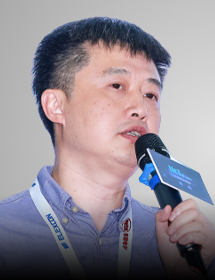Contact:栾春岩
Email Address: luanchunyan@oschina.cn
WeChat (Tel): 15801253940
The Global Open-source Technology Conference (GOTC) is a remarkable open-source technology event for developers all over the world, it was co-initiated by Open Atom Foundation, Shanghai Pudong Software Park,Linux Foundation APAC(LFAPAC), OSCHINA presented and the China communities in the form of industry exhibition, keynotes, special forums and sub-forums, where the participants will discuss and learn the most advanced technology topics such as metaverse, 3D and games, eBPF, Web 3.0, blockchain, as well as other themes such as open source community, open source commercialization, open source education and talent development, cloud-native, etc., in order to explore the future of open source and help with open source development.
10:00-10:20
Evolution of AI Technology: From "Perception Intelligence" to "Cognitive Intelligence" Learn more16:30-17:30
Strengthening Security and Trust in Software Supply Chain: Why SBOM, SLSA, and Sigstore are the Future of Software Engineering Learn more09:15-09:30
Keynote: Developing Open Source Talent in China: The Role of the Linux Foundation Learn more10:00-10:20
Keynote: Ibrahim Haddad from the Linux Foundation in Conversation with Prof. Wang from East China Normal Univesrity - Global Open Source Talent Development Learn more10:20-11:00
Panel Discussion: Open Source and Open Source Talent Development from different perspectives Learn more11:15-11:35
Looking at enterprise open source compliance from the first successful domestic GPL defense case. Learn more 下载PPT09:00-09:30
Software Engineering in the Era of Intelligence: the correct posture of embracing large models Learn more11:00-11:30
Intelligent Code: Exploring the Path from Task-Specific Models to General Large Models. Learn more 下载PPT09:15-09:30
Ecological collaboration between LF CHAOSS community and OSS-Compass community Learn more10:50-11:30
Roundtable - Open Source Community Health Assessment, Illuminating Lights for Your Operations and Governance. Learn more09:20-09:40
From domestic alternatives to fully self-controllable - investment opportunities in hard technology under the gamble of great powers Learn more10:00-10:20
From Industry to Industry - Technology Investment from an Industrial Perspective. Learn more11:00-12:00
Roundtable: National Capital Supports the Development of China's Open Source Ecology, Industry and Enterprises. Learn more15:15-15:50
Operation and maintenance North Star Metric system based on eBPF Trace Profiling Learn more 下载PPT14:00-14:30
Taking HTAP as an example, look at the evolution of modern data stack application architecture and scenarios Learn more 下载PPT15:30-16:00
GreatSQL Open Source Community - Creating a popular open source database in China. Learn more 下载PPT17:00-17:30
Build a domestic distributed database based on openGauss for industrial scenarios Learn more 下载PPT14:15-14:45
Gitee: Ten years of hard work, the domestic leader in code asset management. Learn more 下载PPT14:45-15:10
Solving the last mile of delivery with Delivery As Code - a new form of delivery in the digital age. Learn more 下载PPT15:10-15:30
Construction and Practice Sharing of Agile R&D Platform for Large Financial Enterprises Learn more 下载PPT16:00-16:20
Discussion on the Value of Knowledge Base Construction in DevOps and Release of Gitee Intelligent Knowledge Base Solution for YINXIANG Learn more 下载PPT16:20-16:45
Open Source Governance Solution for Enterprise Software Supply Chain Security Learn more 下载PPT14:00-14:20
Enterprise-level open source supply chain security solution based on network elasticity bill. Learn more 下载PPT14:20-14:40
Sigstore helps the implementation of open source software supply chain security framework SLSA Learn more15:00-15:20
Prevent small risks from becoming big ones and build an open-source security defense system for enterprises Learn more16:00-16:20
Best Practices for Secure Construction of Multi-Workload in Production Environment Learn more 下载PPT16:20-16:40
Open source software supply chain security governance based on code vaccine technology. Learn more 下载PPT16:40-17:00
The Challenges and Practices of Open Source Software Supply Chain Security. Learn more 下载PPT13:30-14:15
What else does WebAssembly need to become a first-class citizen of Rust runtime? Learn more 下载PPT16:30-17:15
Advanced SQL Parser and Efficient Expression Execution Framework implemented in Rust - Design and Implementation of Databend Database Expression Framework. Learn more 下载PPT17:15-18:00
Research and analysis of Rust programming practice issues and automated testing technology Learn more13:30-13:50
The future of JavaScript is coming: accelerated computing, security and portability in the latest standards Learn more13:50-14:30
From alt-JS to var-TS - A review and outlook of variant languages in the JS/TS ecosystem Learn more15:10-15:50
Thinking and exploring the application framework under the concept of "Internet of Everything". Learn more 下载PPT17:10-17:50
More than just improving efficiency - the open source journey of the front-end component library HaloE. Learn more 下载PPT09:40-10:20
The current status of open-source RISC-V cloud computing software and China Telecom's exploration Learn more 下载PPT10:20-11:00
From the development of OpenCloudOS, observe the advancement and progression of open-source operating systems Learn more 下载PPT13:30-14:10
Starting from the implementation and practice of new features in C++, discusses the development trend of the C++ ecosystem and its impact Learn more 下载PPT14:10-14:50
Apache HugeGraph's Open Source Evolution of Distributed Storage and Computing Learn more 下载PPT14:50-15:30
Real-time data integration architecture evolution: from ESB to Kafka to DaaS Learn more 下载PPT09:40-10:00
Prospects and Open Source Opportunities Analysis of the Ultimate Form of Metaverse Learn more 下载PPT13:30-14:00
The integration of open source technology and patented technology in the metaverse. Learn more14:00-14:30
Application of AIGC and large language models based on open source technology Learn more 下载PPT15:00-15:30
As the metaverse returns offline, Space AIGC becomes a technological singularity Learn more15:30-16:00
The Ecological Advantages of Web3D in the Metaverse and Opportunities for WebGPU Engines. Learn more14:00-14:30
Container-based management solution for in-vehicle operating systems applications Learn more 下载PPT16:00-16:30
A vehicle safety inspection tool based on Clang static analysis and symbolic execution - zchecker Learn more 下载PPT10:00-10:20
Application of Large-scale Language Models in Intelligent Document QA: A Solution Based on Langchain and Langchain-serve. Learn more 下载PPT11:20-11:55
PyTorch 2.0: the journey of bringing compiler technologies to the core of PyTorch Learn more13:30-14:00
Deep learning platform + large models to solidify the foundation of industrial intelligence Learn more14:20-14:40
Model inference optimization, exploring the potential of AI implementation Learn more 下载PPT14:40-15:00
Xtreme1 is the next-generation multimodal open-source training data platform Learn more 下载PPT15:00-15:20
OPPO's exploration and practice in the field of mobile graphics technology - O3DE Mobile WG and shaderNN Learn more 下载PPT15:20-15:40
Next-generation knowledge tools: user-centered personalized language models and hybrid deployment strategies. Learn more 下载PPT15:40-16:00
Intel’s Journey with PyTorch: Democratizing AI with ubiquitous hardware and open software Learn more 下载PPT16:00-16:20
DeepRec: High-performance deep learning framework for recommendation scenarios Learn more 下载PPT17:00-17:20
Boost ML Upstream Frameworks with transparent backend graph compilers seamlessly Learn more 下载PPT10:20-10:40
OpenKruise: Comprehensive Enhancement of Cloud-Native Application Management Capability Learn more10:40-11:00
When FinOps Meets Cloud Native - How Tencent Optimizes Cloud Costs Based on Crane Learn more 下载PPT11:00-11:20
Cloud-native technology helps to reduce energy consumption and emissions in data centers Learn more 下载PPT13:30-13:50
A workflow orchestration engine called JobFlow based on the cloud-native batch computing platform Volcano Learn more13:50-14:10
ByteDance's Large-Scale Cluster Federation Technology Practice Based on Kubernetes Learn more 下载PPT14:10-14:30
Cloud-native edge intelligent device management framework: KubeEdge DMI Learn more 下载PPT15:10-15:30
Exploration and Practice of Multi-cluster HPA Based on Karmada by Ctrip Learn more 下载PPT15:50-16:10
Clusterpedia - Aggregated Retrieval of Resources in Multi-Cluster Scenarios. Learn more 下载PPT16:10-16:30
FluidTable: Data Table Abstraction and Elastic Cache System in Cloud-Native Environment. Learn more09:45-10:00
Overview of Baidu Intelligent Edge and MQTT Message Middleware Open Source Project. Learn more 下载PPT10:30-10:45
Build an open source, independent and controllable IoT operating system OneOS Learn more10:45-11:00
The Evolution of Cloud-Native Microservice Governance Technology towards Proxyless Architecture Learn more15:00-15:15
Zhilu OS - an open source intelligent networked roadside unit operating system Learn more 下载PPT Jim Zemlin
Jim Zemlin
 Huaimin Wang
Huaimin Wang
 Zhenyu Hou
Zhenyu Hou
 /
/
 /
/
 /
/
 Rebecca Rumbul
Rebecca Rumbul
 /
/
 Willem Jiang
Willem Jiang
 Hin Yang
Hin Yang
 /
/
 Harris Hui
Harris Hui
 Clyde Seepersad
Clyde Seepersad
 Jie Liu
Jie Liu
Contact:栾春岩
Email Address: luanchunyan@oschina.cn
WeChat (Tel): 15801253940
Contact:Hao Ping
Email Address: haoping@oschina.cn
WeChat (Tel): 13520780247
Contact:栾春岩
Email Address: luanchunyan@oschina.cn
WeChat (Tel): 15801253940

Subscribe our WeChat offical account to get the latest conference information.
